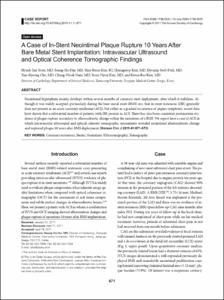KUMEL Repository
1. Journal Papers (연구논문)
1. School of Medicine (의과대학)
Dept. of Internal Medicine (내과학)
A Case of In-Stent Neointimal Plaque Rupture 10 Years After Bare Metal Stent Implantation: Intravascular Ultrasound and Optical Coherence Tomographic Findings
- Keimyung Author(s)
- Yoon, Hyuck Jun; Hur, Seung Ho; Kim, Hyung Seop; Park, Hyoung Seob; Cho, Yun Kyeong; Nam, Chang Wook; Kim, Yoon Nyun; Kim, Kwon Bae
- Department
- Dept. of Internal Medicine (내과학)
- Journal Title
- Korean Circulation Journal
- Issued Date
- 2011
- Volume
- 41
- Issue
- 11
- Keyword
- Coronary restenosis; Stents; Neointima; Ultrasonography; Tomography
- Abstract
- Neointimal hyperplasia mainly develops within several months of coronary stent deployment, after which it stabilizes. Although it was widely accepted, particularly during the bare-metal stent (BMS) era, that in-stent restenosis (ISR) generally does not present as an acute coronary syndrome (ACS), but rather as a gradual recurrence of angina symptoms, recent data have shown that a substantial number of patients with ISR present as ACS. There has also been consistent postmortem evidence of plaque rupture secondary to atherosclerotic change within the neointima of a BMS. We report here a case of ACS in which intravascular ultrasound and optical coherent tomographic assessments revealed neointimal atherosclerotic change and ruptured plaque 10 years after BMS deployment.
- Publisher
- School of Medicine
- Citation
- Hyuck-Jun Yoon et al. (2011). A Case of In-Stent Neointimal Plaque Rupture 10 Years After Bare Metal Stent Implantation: Intravascular Ultrasound and Optical Coherence Tomographic Findings. Korean Circulation Journal, 41(11), 671–673. doi: 10.4070/kcj.2011.41.11.671
- Type
- Article
- ISSN
- 1738-5520
- Appears in Collections:
- 1. School of Medicine (의과대학) > Dept. of Internal Medicine (내과학)
- 파일 목록
-
-
Download
 oak-aaa-03270.pdf
기타 데이터 / 1.01 MB / Adobe PDF
oak-aaa-03270.pdf
기타 데이터 / 1.01 MB / Adobe PDF
-
Items in Repository are protected by copyright, with all rights reserved, unless otherwise indicated.